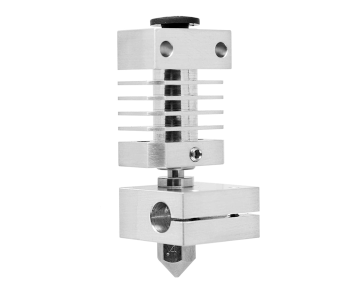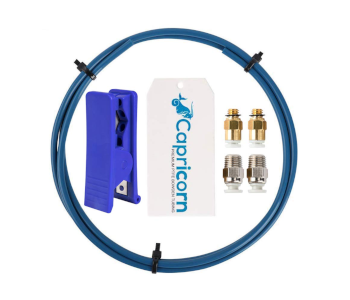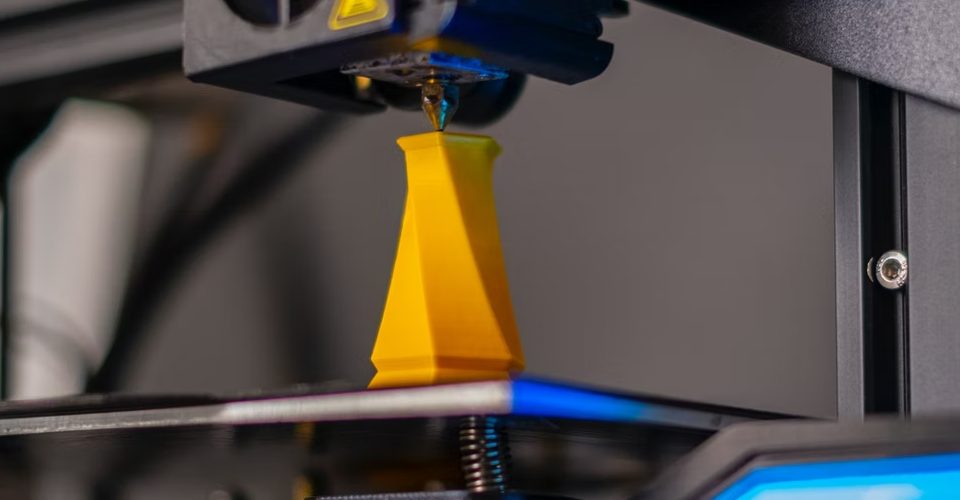Everything You Need to Know About 3D Printer Heat Break
The heat break is probably one of the smallest and least noticeable parts of a 3D printer. However, it is an important part of a 3D printer’s hot end – undoubtedly one of the most essential components of a 3D printer. Developing an understanding of how the heat break works provides an opportunity to fine-tune the performance of the hot end and avoid potential extrusion issues.
What is a heat break and what does it do?

To understand the importance of the heat break, we must first understand what goes on in the hot end of a 3D printer.
At the most basic level, the hot end exposes the filament to temperatures that are high enough to cause the filament to melt and be extruded through the nozzle. The heat introduced in this zone not only needs to be precise, but also controlled. This is because allowing the heat to spread uncontrollably can cause the filament to swell, thus causing issues with extrusion.
The purpose of the heat break is to create a separation between an extruder’s hot zone and cold zone. While the hot zone melts the filament, the cold zone should keep the filament solid enough to allow it to be grabbed by the extruder gears.
The heat break accomplishes this with the help of another component – the heat sink. The heat sink is made of a conductive material, typically designed for maximum surface area. This heat sink draws heat away from the heat break and passively dissipates it to the environment.
Most 3D printers come with a heat break made with metal and an internal PTFE lining. This serves the purpose of reducing the friction as the filament enters the hot zone. However, there are also all-metal or bimetallic options. Each of these heat break options has advantages, disadvantages, and specific scenarios where they are most appropriate.
What to do when heat creep happens
When heat creep happens, it only means that the heat break of your 3D printer has failed in fulfilling its purpose. The most apparent sign of heat creep is a gradual buildup of filament in the heat break. This disrupts the extrusion process, eventually causing under-extrusion issues such as gaps or missing layers. When left unchecked, the filament can effectively clog the hot end until a point when extrusion is no longer possible.
Poor performance of the heat break does not necessarily mean that it needs to be replaced or swapped with another type of heat break. Setting too high temperatures on the hot end can cause heat creep, even when the heat break and heat sink are working optimally.
Other possible remedies for a heat creep are the reapplication of thermal grease between the heat sink and heat break, or the introduction of active cooling (via fan) directed at the heat break. If these still do not solve heat creep issues, then a re-evaluation of the heat break may be in order.
Different types of heat break
As mentioned, there are different types of heat breaks available today that are made of different materials. All of these are widely used, so there isn’t really a single heat break type that is considered the best. Let’s look at each heat break type and its benefits and drawbacks:
Stainless steel w/ PTFE tubing

Most 3D printers come with a stock heat break made of stainless steel with an internal PTFE tubing. This combination works particularly well because the stainless steel does a good job of drawing heat away from the hot zone while the PTFE tubing reduces friction to help with filament flow. If you’re not having any trouble with a stock heat break, then there really is no reason to swap it out.
This type of heat break typically fails when printing at very high temperatures. This is because PTFE degrades at extremely high temperatures – usually above 240 C. When this happens, the PTFE tubing will have to be replaced for the heat break to be used continuously.
Titanium
Most all-metal hot ends are made of titanium. This material is mechanically stronger and less conductive than stainless steel, effectively creating a thermal barrier between the hot zone and the cold zone.
The chief advantage of a titanium heat break is that it does not deteriorate under extremely high temperatures. This makes it more suitable for printing with high-temperature filaments such as Nylon, PC, or PEEK.
However, titanium heat breaks also present a few unique challenges. In the absence of a PTFE liner, filament flow through the heat break goes through a higher level of friction. This is particularly problematic if your 3D printing project requires a lot of retraction.
When retraction occurs, filament from the melt zone is effectively pulled towards the heat break. This can cause a sudden drop of temperature and re-solidification of the filament. This effectively creates a plug that may cause jamming in the extruder.
Bimetallic
Bimetallic heat breaks are so-called because they are constructed using two different metals. The inside of the heat break contains a very thin tube of stainless steel that reduces friction and provides a sharp heat transition. This is then enveloped by a thick layer of copper.
Compared to stainless steel or titanium, copper has very high thermal conductivity. When this comes in contact with the hot end, a bimetallic heat break effectively expands the melting zone. This allows for consistent extrusion at faster printing speeds. If you want to print with high-temperature filaments or use larger nozzles, then a bimetallic heat break should be beneficial.
The use of copper at the lower thread of a bimetallic heat break might extend the melting zone, but it is also very effective in drawing out heat. As long as you have the heat sink set up properly, heat creep should not be a huge problem. However, a poorly optimized heat sink will almost certainly lead to heat creep.
Another downside of a mostly copper construction is that it makes bimetallic heat breaks quite fragile. Don’t expect these to be as robust as heat breaks made of stainless steel. Bimetallic heat breaks are also typically more expensive owing to the more precise engineering involved in manufacturing them.
Does your heat break need replacement?
There are two good reasons for doing a heat break replacement. The first is if it starts causing you problems, especially if you’re still using a stock heat break with PTFE tubing. The PTFE inevitably will get worn down after repeated use and will require periodic replacement. As mentioned, PTFE tubing is not suitable for printing with filaments that require very high temperatures. If this becomes a frequent problem, then making a permanent upgrade to an all-metal hot end may be worth considering.
The second reason to do a heat break replacement is if you are experiencing extrusion or heat creep issues with your current printer settings. If you want to print at higher speeds, then a bimetallic heat break is certainly more suitable. The high thermal conductivity of the copper jacket of bimetallic heat breaks also makes heat creep a more manageable issue to avoid.
The great thing about all-metal or bimetallic metal heat breaks is that they can last indefinitely if they are not damaged mechanically due to mishandling. They practically last forever, or at least as long your 3D printer remains functional.
Final thoughts
The heat break is a very small part of a 3D printer, but it plays a critical role in maintaining good extrusion and avoiding jamming in the hot end. It is also one of the parts of the 3D printer that is easiest to be replaced.
Heat breaks made of titanium or bimetallic material have become quite common in recent years. While these seem like upgrades to stock heat breaks, they really are only appropriate for specific scenarios. Our advice is to not do a heat break replacement unless you absolutely need to, as there could still be drawbacks that you will have to deal with.





